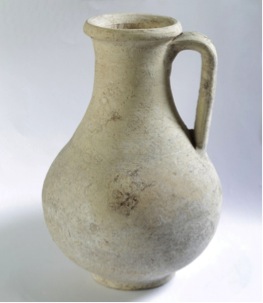Cappuccina Tomb
The remains of the Roman necropolis in ancient Sulky have largely disappeared, due to the fact that the Romans created their imperial necropolis above the Punic underground one, often using dromoi to lay their dead, so burials tended to stay close to the surface and were therefore exposed to damage or destruction due to agricultural work or to other reasons. The Capuccina tomb is one of the most characteristic burial forms from the Roman imperial age and is intended for the lower classes of society (fig. 1): in fact, they are often very poor, in some cases altogether lacking any grave goods of the deceased.

They are constructed with a bed of clay roof tiles, on which the deceased was placed, which was then covered by other large tiles arranged as a pitched roof (fig. 2).

In other cases, the deceased was laid directly on the bare ground, in a wooden coffin or on a litter still made of wood: this aspect is evidenced by the discovery of iron nails in eight of Sulky’s twenty tombs.
The Cappuccina tombs of Sant'Antioco are usually placed in a shallow grave dug in tuff and with the tiles supported by stones or plates. The roof tiles may be three or four per side. Only a small percentage of these tombs had grave goods. These are poor grave goods, typically made up of various pottery, oil lamps and sometimes coins, representing offerings for the ferryman who ferried souls from the world of the living to that of the dead (figs. 3-4).


One last finding that is worth mentioning is a small statue of Venus which still retains its original colours and which was found in a Cappuccina tomb then renamed the "Tomb of the Blonde Venus" (fig. 5). As concerns the dating of the examined tombs in Sulky, on the basis of the study of the grave goods, they can be placed in a period between the II and III centuries A.D.

Bibliografia
- C. TRONCHETTI, S. Antioco, Sassari 1989.
- C. TRONCHETTI, La necropoli romana di Sulci. Scavi 1978: relazione preliminare = Quaderni della Soprintendenza Archeologica per le Province di Cagliari e Oristano, Cagliari 1990, pp. 173-192.

 VR
VR